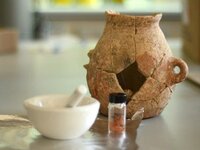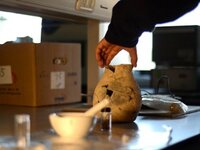DeepseekerADS
Gold Member
- Mar 3, 2013
- 14,880
- 21,733
- Detector(s) used
- CTX, Excal II, EQ800, Fisher 1260X, Tesoro Royal Sabre, Tejon, Garrett ADSIII, Carrot, Stealth 920iX, Keene A52
- Primary Interest:
- Other
http://www.theblaze.com/stories/2014/12/17/olive-oil-said-to-be-8000-years-old-found-in-israel/
Dec. 17, 2014 1:37pm Sharona Schwartz
An archaeological discovery in Israel suggests olive oil may have been a part of the Mediterranean diet going back as far as 8,000 years.
The Israel Antiquities Authority said a study of pottery shards found in Israel’s Galilee region indicates that olive oil was used as early as the sixth millennium B.C., and may show the earliest-known use of olive oil in the Middle East.
Ianir Milevski and Nimrod Getzov of the Israel Antiquities Authority led an excavation in Tzipori in northern Israel from 2011 to 2013. Together with Dvory Namdar of the Hebrew University of Jerusalem’s Institute of Earth Sciences, they worked to extract and identify organic remains found on the shards of 20 pottery vessels found at the site.
Among the pottery shards that were found in northern Israel.

Pottery shards found in northern Israel are believed to show the earliest known use of olive oil in the Middle East. (Photo courtesy Israel Antiquities Authority)
Of the 20, two were dated by the researchers to approximately 5,800 B.C.
Their findings were published in an article in the Israel Journal of Plant Sciences. In a press release from the Israeli Antiquities Authority on Wednesday, the researchers said, “It seems that olive oil was already a part of the diet and might also have been used for lighting.”
“Although it is impossible to say for sure, this might be an olive species that was domesticated and joined grain and legumes – the other kinds of field crops that we know were grown then,” the researchers said.

“With the adoption of olive oil the basic Mediterranean diet was complete. From ancient times to the present, the Mediterranean economy has been based on high quality olive oil, grain and must (grape juice), the three crops frequently mentioned in the Bible,” they said.
If as old as is being suggested, the pottery would date to the Early Chalcolithic period, also known as the Copper Age.
Of particular note, when researchers compared the composition of the ancient oil to modern year-old olive oil, the two showed a strong resemblance, an indication of how well preserved the substance was for thousands of years.

Israel’s Arutz Sheva news site lauded the news of the find, which was timed to the Jewish holiday of Hanukkah.
“Just in time for Hanukkah, the Jewish holiday celebrating the miracle in which olive oil burned eight days instead of one as the Maccabees restored the Temple and fought off Greek occupiers, an unprecedented archaeological find has unearthed 8,000-year-old olive oil jar shards,” Arutz Sheva observed.
Milevski said the community using the oil was pre-Jewish whose religion revolved around worshiping fertility.
“We have no writing during that period so we know little about them. We do not know what language they spoke but we assume it was an early Semitic language, from which Babylonian and Akkadian evolved and later also Hebrew and Arabic,” Milevski said, according to the Times of Israel.
In the same area where the pottery shards were found, archaeologists found engravings of female images and animals.
“In the same site we also found bones from the limbs of large animals engraved with images of eyes, trees and triangles symbolizing the female sex,” Milevski added.
Dec. 17, 2014 1:37pm Sharona Schwartz
An archaeological discovery in Israel suggests olive oil may have been a part of the Mediterranean diet going back as far as 8,000 years.
The Israel Antiquities Authority said a study of pottery shards found in Israel’s Galilee region indicates that olive oil was used as early as the sixth millennium B.C., and may show the earliest-known use of olive oil in the Middle East.
Ianir Milevski and Nimrod Getzov of the Israel Antiquities Authority led an excavation in Tzipori in northern Israel from 2011 to 2013. Together with Dvory Namdar of the Hebrew University of Jerusalem’s Institute of Earth Sciences, they worked to extract and identify organic remains found on the shards of 20 pottery vessels found at the site.
Among the pottery shards that were found in northern Israel.

Pottery shards found in northern Israel are believed to show the earliest known use of olive oil in the Middle East. (Photo courtesy Israel Antiquities Authority)
Of the 20, two were dated by the researchers to approximately 5,800 B.C.
Their findings were published in an article in the Israel Journal of Plant Sciences. In a press release from the Israeli Antiquities Authority on Wednesday, the researchers said, “It seems that olive oil was already a part of the diet and might also have been used for lighting.”
“Although it is impossible to say for sure, this might be an olive species that was domesticated and joined grain and legumes – the other kinds of field crops that we know were grown then,” the researchers said.

“With the adoption of olive oil the basic Mediterranean diet was complete. From ancient times to the present, the Mediterranean economy has been based on high quality olive oil, grain and must (grape juice), the three crops frequently mentioned in the Bible,” they said.
If as old as is being suggested, the pottery would date to the Early Chalcolithic period, also known as the Copper Age.
Of particular note, when researchers compared the composition of the ancient oil to modern year-old olive oil, the two showed a strong resemblance, an indication of how well preserved the substance was for thousands of years.

Israel’s Arutz Sheva news site lauded the news of the find, which was timed to the Jewish holiday of Hanukkah.
“Just in time for Hanukkah, the Jewish holiday celebrating the miracle in which olive oil burned eight days instead of one as the Maccabees restored the Temple and fought off Greek occupiers, an unprecedented archaeological find has unearthed 8,000-year-old olive oil jar shards,” Arutz Sheva observed.
Milevski said the community using the oil was pre-Jewish whose religion revolved around worshiping fertility.
“We have no writing during that period so we know little about them. We do not know what language they spoke but we assume it was an early Semitic language, from which Babylonian and Akkadian evolved and later also Hebrew and Arabic,” Milevski said, according to the Times of Israel.
In the same area where the pottery shards were found, archaeologists found engravings of female images and animals.
“In the same site we also found bones from the limbs of large animals engraved with images of eyes, trees and triangles symbolizing the female sex,” Milevski added.




